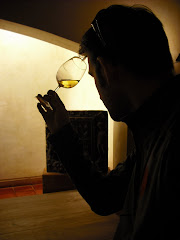After lunch at Niagara College, a walk along Queen street in the historic district is wonderful to help digest. There are countless articles on the history of the area but I'll hightlight some of the key sights and give you a more personal account.
In the winter time (after November 1st) you can find free parking just about everywhere. In the summer, free parking is difficult to spot, so try the streets around the residential neighbourhood to the south of Queen st. Otherwise, parking along Queen st. or on the north side streets comes at a relatively low cost.
It's nice to start your stroll at the west end of Queen, nearby the Niagara-on-the-Lake Golf Club, and heading eastward towards the obelisk (below).
Stop in at
Victoria Gallery and Teas (108 Queen st.) for a specialty tea, or take some home, either in bags or as looseleaf. There are some very interesting, uniquely Canadian infusions such as icewine and maple syrup. Coffee lovers are not left out in the cold either as there are plenty of classics and unique roasts to enjoy.
For the sweet tooth,
Maple Leaf Fudge (114 Queen st.) offers a suite of exceptional bricks of creamy fudge and chocolate confections. There are bulk candies for sale, maple syrup, and a collections of Ty-branded stuffed animal figures for all you collectors out there.
Continuing down the street are more shops featuring clothing and kitchenwares. Unfortunately, very few of these stores withstand the test of the economy and are replaced on an almost annual basis. Some resist the revolving door because they are so unique, and their contents really draw the visitors. Of note is the clothing, gift and jewlery store,
Irish Design (75 Queen st.), which also has a nice patio and tea room. At
Just Christmas (34 Queen st.), the spirit of the season lasts all year and is chock full of nice ornaments for decorating. The staff will paint your name on glass Christmas balls for a personal touch to your tree.
Greaves Jams and Marmalades Ltd. (55 Queen st.) have pretty much any flavour of delicious jam or jelly, along with chutney, salsa, honey and gourmet sauce you like for your kitchen pantry. Your nose, and temptation, may get the better of you if you visit the
Niagara Home Bakery (66 Queen st.), be sure to save some of those yummy baked goods and pies for your friends too. Have a laugh at the quirky, cow related puns on clothing and other items at
Cows (44 Queen st.). Other stores that have been around for more than just a few seasons include some recognizable franchises including
Crabtree & Evelyn,
Ten-thousand Villages, the
LCBO, and
Rocky Mountain Chocolate Factory.
Storefronts on the north side of Queen st. A new wine and tapas restaurant,
Cork's (left), Crabtree and Evelyn (second from left), and the Niagara Apothecary (right)

There are plenty of places to eat. If I could just mention a few where I have had great experiences, or are curiously worth visiting, they would be the expensive but excellent
Escabeche restaurant (at the
Prince of Wales Hotel [right], 6 Picton, st.). Their wine list includes plenty of fantastic Canadian examples that you may not be familiar with, because they aren't found in the LCBO. The sommelier has been there for many years. He is very friendly, knowledgeable, and never scoffs at you if all you want to order is a simple glass to try, or perhaps no wine at all. The more reasonably priced yet very tasty
Bistro Six-One (61 Queen st.) has a relaxed atmosphere and is warmly decorated -- a great place for brunch. Unfortunately, some of the others have been hit-or-miss on the quality of their food (The Shaw Cafe, although very pretty both inside and out, is too busy, too overpriced, and has not consitently delivered on quality -- and I've given them three chances).
Other than stores and restaurants, be sure to visit the Niagara Apothecary (free; northwest corner of Queen and King; open during the spring and summer only) for a look into our pharmaceutical past. Tricia Romance's The Romance Collection Gallery (177 King st) is a beautiful house with great gardens and wonderful artwork.

Photo opportunites can be had along the lakefront at the foot of King street. Visit the gazebo (right), and the beach walkway of the
Queen's Royal Park all the way back to your startpoint near the golfcourse. While you stroll, take in the sights of the beautiful boats afloat in lake Ontario, the old
Fort Niagara (below; across the river is Youngstown, New York, in the United States), a major fort during the war of 1812, and on a clear day, if you look northwest, you can see the CN tower back in Toronto.

After a long day of exploring, and enjoying some of Ontario's fantastic wine and culinary delights. It would be a great treat to cap off the evening and stay the night. You can somewhat blow the budget, splurge, but be served like royalty, at the Prince of Wales Hotel (with breakfast packages that average $250 per night, for a traditional King size bed, prices fluctuate due to seasonality). However, there is a whole other industry that is truly booming. The Bed & Breakfast option (with well over 300 unique establishments) is affordable, hospitable and a great way to experience Niagara's history first hand.
More to come...













